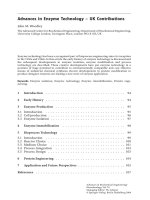coronary angiography - advances in noninvasive imaging - b. baskot (intech, 2011)
Bạn đang xem bản rút gọn của tài liệu. Xem và tải ngay bản đầy đủ của tài liệu tại đây (25.46 MB, 426 trang )
CORONARY ANGIOGRAPHY
– ADVANCES IN
NONINVASIVE
IMAGING APPROACH
FOR EVALUATION
OF CORONARY
ARTERY DISEASE
Edited by Branislav Baškot
Coronary Angiography – Advances in Noninvasive Imaging Approach for
Evaluation of Coronary Artery Disease
Edited by Branislav Baškot
Published by InTech
Janeza Trdine 9, 51000 Rijeka, Croatia
Copyright © 2011 InTech
All chapters are Open Access articles distributed under the Creative Commons
Non Commercial Share Alike Attribution 3.0 license, which permits to copy,
distribute, transmit, and adapt the work in any medium, so long as the original
work is properly cited. After this work has been published by InTech, authors
have the right to republish it, in whole or part, in any publication of which they
are the author, and to make other personal use of the work. Any republication,
referencing or personal use of the work must explicitly identify the original source.
Statements and opinions expressed in the chapters are these of the individual contributors
and not necessarily those of the editors or publisher. No responsibility is accepted
for the accuracy of information contained in the published articles. The publisher
assumes no responsibility for any damage or injury to persons or property arising out
of the use of any materials, instructions, methods or ideas contained in the book.
Publishing Process Manager Iva Simcic
Technical Editor Teodora Smiljanic
Cover Designer Jan Hyrat
Image Copyright Jeffrey Collingwood, 2010. Used under license from Shutterstock.com
First published August, 2011
Printed in Croatia
A free online edition of this book is available at www.intechopen.com
Additional hard copies can be obtained from
Coronary Angiography – Advances in Noninvasive Imaging Approach for Evaluation of
Coronary Artery Disease, Edited by Branislav Baškot
p. cm.
ISBN 978-953-307-675-1
free online editions of InTech
Books and Journals can be found at
www.intechopen.com
Contents
Preface IX
Chapter 1 Utilization of Functional Tests
Prior to and Adherence to
Guidelines on Coronary Angiography 1
James T Leung and Dominic Y Leung
Chapter 2 Transthoracic Echocardiography
in the Assessment of Coronary Arteries 21
Alla Boshchenko, Alexander Vrublevsky and Rostislav Karpov
Chapter 3 Contrast Echocardiography
in Coronary Artery Disease 61
Mai Tone Lønnebakken and Eva Gerdts
Chapter 4 Non-Invasive Imaging
in Approaching Ischemic
Coronary Artery Disease 81
Lucia Agoston-Coldea, Teodora Mocan and Silvia Lupu
Chapter 5 Non-Invasive Coronary Angiography 99
Mohanaluxmi Sriharan, Paula McParland,
Stephen Harden
and Edward Nicol
Chapter 6 Coronary CT Angiography
as an Alternative to Invasive Coronary Angiography 123
Seshu C. Rao and Randall C. Thompson
Chapter 7 New Noninvasive Modalities
in Coronary Angiography:
Cardiac Computed Tomography Angiography 141
Ryotaro Wake and Minoru Yoshiyama
Chapter 8 Simultaneous Assessment Beyond
Coronary Stenosis by
Multislice Computed Tomography 151
Shoichi Ehara and Kenei Shimada
VI Contents
Chapter 9 Assessment of Coronary Artery Bypass Graft
(CABG) Patency and Graft Disease Using
Multidetector Computed Tomography (MDCT) 161
Bong Gun Song, Hyun Suk Yang, Joon Hyung Doh, Hong Jang,
Gu Hyun Kang, Yong Hwan Park, Woo Jung Chun, Ju Hyeon Oh,
Sung Min Ko and Hweung Kon Hwang
Chapter 10 Detection Myocardial Bridging
Using Non-Invasive Technique 183
Junbo Ge and Jianying Ma
Chapter 11 When Cardiac Computed Tomography
Becomes the Gold Standard Technique
to Evaluate Coronary Artery Disease Patients 199
Mohamed Bamoshmoosh
Chapter 12 Physiologic Risk Assessment
in Stable Ischemic Heart Disease
– Functional Evaluation Versus Coronary Anatomy 215
Alessia Gimelli and Paolo Marzullo
Chapter 13 Clinical Significance of Tetrofosm in Extracardiac
Uptake During Myocardial Perfusion Imaging 225
Panagiotis Georgoulias, Varvara Valotassiou, Ioannis Tsougos,
George Angelidis and Nikolaos Demakopoulos
Chapter 14 Myocardial Perfusion Imaging in Diagnosis
of Culprit Lesion in Patients Undergoing
Elective Percutaneous Coronary Intervention 249
Branislav Baskot, Slobodan Obradovic, Saso Rafajlovski,
Branko Gligic, Robert Jung, Vladimir Ivanovic, Miroslav Bikicki
and Miodrag Pavlovic
Chapter 15 New Noninvasive Modalities in
Coronary Angiography - Diagnostic Values
of New Biomarkers for Cardiovascular Disease 267
Yilmaz. N, Yegin A and Aykal G.
Chapter 16 The Role of Inflammatory Biomarkers
in the Assessment of Coronary Artery Disease 281
Patrícia Napoleão, Mafalda Selas, Cláudia Freixo, Catarina Ramos,
Valeska Andreozzi, Antónia Turkman, Miguel Mota Carmo,
Ana Maria Viegas-Crespo, Rui Cruz Ferreira and Teresa Pinheiro
Chapter 17 Platelet, Fatty Acids, Membrane Viscosity,
Depression and Ischemic Heart Disease
- Biological-Molecular Path, with
Medical-Anthropology Insights 315
Massimo Cocchi, Lucio Tonello and Fabio Gabrielli
Contents VII
Chapter 18 Acceleration of New Biomarkers Development and Discovery
in Synergistic Diagnostics of Coronary Artery Disease 353
Ewa Stępień
Chapter 19 Biomarkers and Coronary Atherosclerotic
Burden and Activity as Assessed by Coronary
Angiography and Intra-Coronary Imaging Modalities 375
Valentina Loria, Nicola Cosentino, Rocco A Montone and
Giampaolo Niccoli
Preface
This book brings together contributions from around the world, investigators who are
clinical versus imaging science in their orientation, and representatives from academic
medical centers and the imaging industry. Each article is written to be accessible to
those with a basic knowledge of coronary imaging but also to be stimulating and
educational to those who are experts and investigators in medical imaging.
This book covers where advances have been dramatic in the past two decades and
shows the major contributions of the imaging scientists and engineers from both
academia and industry. Patients with know or suspected coronary artery disease who
are asymptomatic or who have stable symptoms are often evaluated noninvasive.
Functional test, such as stress electrocardiography, stress echocardiography, and stress
nuclear perfusion imaging, detect and quantity the presence of ischemia based on
electrical, mechanical, or perfusion abnormalities, indirectly, but nuclear perfusion
imaging directly, establishing the burden of coronary artery disease. Multidetector CT
(MDCT) has emerged as a tool to evaluate noninvasive the coronary anatomy. MDCT
has overcome many of its original limitations and now provides ECG-gated
acquisition with short acquisition time, sub millimeter spatial resolution, allowing
excellent visualization of the coronary arteries. Over the last 15 years, the rate of
technologic advancements leading to improved coronary angiography with MDCT
has rapidly exceeded those of other cardiac imaging modalities. Image quality is
undergoing constant refinement, and the number of uninterpretable coronary studies
has gradually decreased from 20%-40% using for detector, to 15% - 25% with 16-
detector, and is now as low as 3% to 10% with 64-detector systems.
But this section is also devoted to the current state of myocardial perfusion imaging
(MPI). MPI is well establishment imaging techniques and is already integral part of the
management of coronary artery disease (CAD), and is included in a number of
professional guidelines. Coronary angiography, considered the “gold standard” for
the diagnosis of CAD, often does not provide information about the functional
significance of coronary stenosis, especially in borderline lesions. Andres Gruentzig
said; when coronary angiography founded coronary narrowing, I would like to have some kind
of diagnostic procedure who gives me functional significance that lesion. MPI is very
important diagnostic tool for the diagnosis culprit lesions, and indicating who patients
have for cardiovascular intervention (PCI or ACBP). The predominant theme is that
X Preface
MPI finding can serve as the gatekeeper for more costly and more risky invasive
strategies in the evaluation and treatment of patients with coronary artery disease.
The book Coronary Angiography – Advances in Noninvasive Imaging Approach for
Evaluation of Coronary Artery Disease includes a series of articles that provide a state‐
of‐the‐art summary of the current clinical applications of cardiac CT, reviews data that
support the accuracy and the prognostic use of CT coronary angiography and reports
of the newest technological advances and promising future applications of these
imaging modalities. Its also provide other diagnostic approach like functional test,
which finding helps to make decision about invasive strategies with best benefit for
patients.
Finally, the next decades should see even greater advances in the field, and such
breakthroughs will be instrumental in further enhancing the information that can be
derived from functional testing for the assessment of myocardial blood flow, cardiac
function, and myocardial viability.
Readers of Coronary Angiography will enjoy in this book and will find the information
and expert opinions very useful to their clinical practice.
Branislav Baškot MD PhD Ass Prof
Department of Nuclear Medicine Imaging “Dr Baskot”
Belgrade,
Serbia
1
Utilization of Functional Tests Prior
to and Adherence to Guidelines
on Coronary Angiography
James T Leung
1
and Dominic Y Leung
2
1
Sydney Medical School, University of Sydney,
2
Liverpool Hospital, University of New South Wales,
Australia
1. Introduction
Coronary angiography is one of the most commonly performed investigations in clinical
cardiology and remains the “gold standard” in the anatomical diagnosis of coronary artery
disease. It is often required to establish the diagnosis of coronary disease and to provide a
map of a patient’s coronary artery anatomy prior to percutaneous coronary intervention or
coronary artery bypass surgery.
Despite its importance, invasive coronary angiography should not be performed in all
patients suspected to have coronary artery disease. Functional tests, such as stress ECG,
echo or nuclear perfusion imaging, are often recommended as initial tests for many of these
patients. These functional tests are widely available and practised. In addition to their
diagnostic value, functional tests provide independent and additional prognostic
information (Marwick et al., 1997). Furthermore, functional tests are often required to guide
management of patients with intermediate lesions on invasive coronary angiography.
According to the Bayesian theorem, the impact of a screening test is most significant in
patients with intermediate pre-test probability of disease. Furthermore, cost-effectiveness
analyses often reveal that the use of screening tests in these patients is the most favourable
approach. Despite the established roles of functional tests and their extensive incorporation
in best practice guidelines, there is little data on the extent of their use and on how the
results of such tests are utilised prior to referral to coronary angiography in patients with
low to intermediate pre-test probabilities of coronary disease.
Guidelines have proliferated in cardiology in recent years. Major professional bodies like
the American College of Cardiology, American Heart Association and the European Society
of Cardiology have published guidelines on a wide range of cardiovascular disorders and
cardiovascular investigations. These guidelines incorporate the latest evidence base and
provide recommendations, which are intended to improve the quality of patient care and
clinical outcomes whilst minimising costs. These recommendations are based on the most
effective and evidence-based strategies. The American College of Cardiology and American
Heart Association have published comprehensive guidelines on the use of coronary
angiography (Scanlon et al., 1999). The guidelines were initially published in 1987 and were
revised in May of 1999. These guidelines provide recommendations for coronary
Coronary Angiography
– Advances in Noninvasive Imaging Approach for Evaluation of Coronary Artery Disease
2
angiography in clinical scenarios such as patients with known or suspected coronary artery
disease, stable or unstable angina pectoris, acute coronary syndromes, recurrence of
symptoms after revascularization, congestive heart failure or other conditions.
There has been considerable interest in evaluating compliance with guidelines in clinical
practice. This is particularly pertinent as improved compliance with treatment guidelines is
associated with better clinical outcomes in patients with acute coronary syndromes (Schiele
et al., 2005). Despite the widespread dissemination of the guidelines on coronary
angiography, the compliance rate with these guidelines in clinical practice and the
relationship between compliance and results of angiography has not been prospectively
evaluated.
As discussed in other chapters, computed tomography (CT) coronary angiography is now
increasingly being used to evaluate patients with suspected coronary artery disease. The
American College of Cardiology, together with other professional bodies, has published
criteria for the appropriate use of CT coronary angiography (Hendel et al., 2006). CT
coronary angiography will increasingly be incorporated into clinical practice as an
important imaging modality for the evaluation of patients suspected to be suffering from
coronary artery disease. An important consideration for clinicians and administrators will
be the diagnostic value of imaging tests and their cost effectiveness in these patients. More
data has recently become available regarding the incremental value of functional testing and
other imaging modalities like CT coronary angiography in patients with suspected coronary
artery disease. In particular, the incremental value of non-invasive testing in risk
stratification and the prediction of adverse events in these patients will be of interest in
guiding practice and, more importantly, health care policy.
2. Utilisation of functional tests prior to coronary angiography
As discussed earlier, despite their well-documented clinical usefulness, there is little
information on the pattern of use of functional tests in patients prior to undergoing invasive
coronary angiography. In particular, for patients who are subsequently found to have no
significant coronary artery disease on coronary angiography, it will be interesting to
examine how and why they ended up having invasive coronary angiography. It may be
argued that, for these patients, a “failure” of the investigative algorithms led them to
undergo an invasive test, which may not have been indicated and should not have been
performed. These tests should have been avoided as they exposed the patient to needless
risks and might have been unnecessary monetary, resource and manpower wastes. By
examining where the process has “failed”, one will hopefully be able to learn how to
minimise future such “failures”. The purpose of our study was to analyse the patterns of use
and the results of functional tests in patients found to have normal coronary arteries on
invasive coronary angiography.
2.1 The study - methods
Over a 7 and a half-year period, a total of 6,409 patients underwent 8,069 coronary
procedures at our hospital. Our hospital is the only tertiary referral centre serving a
population of about 800,000 people. Only patients referred for coronary angiography for
evaluation of coronary artery disease were included in the analysis. Angiographic studies
on patients referred for valvular or haemodynamic indications were excluded from the
Utilization of Functional Tests Prior to and Adherence to Guidelines on Coronary Angiography
3
analysis. Patients with documented coronary artery disease referred for coronary
angioplasty or other percutaneous intervention were also excluded. Therefore, the study
included 6,053 patients who underwent a total of 6,830 coronary angiographic procedures.
Of the 6,830 procedures, 4,610 were for male patients and 2,220 were for female patients.
The mean age of the patients was 60.9 ± 11 years. Clinical information, including age and
gender, referrer details, indications for angiography, type of the study and subsequent
results, was prospectively collected and entered into a computerised database.
Coronary angiography was performed according to standard techniques via either the
femoral, brachial or radial approaches. Patients with no angiographically detectable disease
or irregularities in any of the epicardial coronary arteries were considered to have normal
coronary arteries on angiography. Patients who had previously undergone coronary artery
bypass surgery and who were found to have patent bypass grafts on angiography were not
considered to have normal coronary arteries.
Patients who were subsequently found to have normal coronary arteries on angiography
were identified. The clinical records of these patients were then reviewed. Their clinical
characteristics and presenting symptoms, including risk factors for coronary artery
disease, were analysed. Chest pain as the main presenting symptom was characterized on
retrospective chart review as typical, atypical or non-anginal/non-specific pain. Five risk
factors were considered: diabetes mellitus, cigarette smoking, hypertension,
hypercholesterolemia and family history of coronary artery disease. Patients’ pre-test
probabilities of coronary artery disease were estimated from age, gender and presenting
symptoms (Diamond & Forrester, 1979).
The types and results of functional tests, if performed for these patients, were recorded and
analysed. Results of functional tests including exercise ECG, exercise or pharmacologic
stress echocardiogram or nuclear myocardial perfusion studies were sought. None of the
patients had CT coronary angiography as it was not available at the time of the study.
Functional tests were considered negative if no evidence of inducible ischaemia was
detected on testing and if the level of the stress was considered adequate. Functional tests
were considered inconclusive if there was equivocal evidence of inducible ischaemia or if
there was no inducible ischaemia at inadequate levels of stress.
Information on the physicians who referred these patients (referrers) for coronary angiography
was also recorded. Referrers were classified into cardiologists or other physicians according to
the field of specialisation. In particular, for cardiologist referrers, those who performed
coronary angiography were considered proceduralists whilst cardiologists who do not
perform angiography were considered non-proceduralists.
2.2 Results
2.2.1 Patients
Seven hundred and fifty six patients undergoing 762 procedures were found to have normal
epicardial coronary arteries on angiography. This means that 11.2% of the coronary
angiograms performed were for patients with normal coronary arteries. The mean age of
these patients was 54.9 ± 11.5 years with female patients comprising 54.9%. Clinical
information was obtainable in all but 4 patients (99.5%). The mean number of coronary risk
factors was 1.5 ± 1. The mean pre-test probability of coronary artery disease was 41.7 ± 30%
(median 46.1%, inter-quartile range 14.1 - 58.9%). Three hundred and thirteen patients
underwent coronary angiography as hospital inpatients while 445 patients underwent
coronary angiography as a day-only procedure on an outpatient basis. There were no
Coronary Angiography
– Advances in Noninvasive Imaging Approach for Evaluation of Coronary Artery Disease
4
significant differences in gender distribution, number of coronary risk factors and pre-test
probability of coronary artery disease between patients who underwent coronary
angiography as inpatients and those who underwent the procedure as day-only patients.
However, patients who underwent coronary angiography as inpatients were significantly
younger and more likely to have presented with non-anginal chest pain (Table 1).
Parameters
Inpatient procedure
(n=313)
Day-only procedure
(n=445)
p
Men/Women 149/164 199/246 0.43
Age (years) 53.6 12.5 55.8 10.8 0.01
Number of risk factors
1.48 1.1 1.49 1
0.73
Presenting symptom
n (%) <0.001
Typical angina 62 (19.8%) 99 (22.2%)
Atypical angina 110 (35.1%) 172 (38.7%)
Non anginal chest pain 85 (27.2%) 71 (15.9%)
Dyspnea 23 (7.3%) 48 (10.8%)
Others 26 (8.3%) 34 (7.6%)
Asymptomatic 2 (0.6%) 16 (3.6%)
Pre-test probability of
coronary disease (%) 39.6 30 43.2 29.8 0.11
Table 1. Clinical characteristics of patients who were subsequently found to have
angiographically normal coronary arteries divided according to whether they were hospital
inpatients or not at the time of angiography. (Reproduced with permission from: Leung DY,
Lo ST, Liew CT, Wong A, Hopkins AP, Juergens CJ. Utilization of functional tests prior to
coronary angiography in patients with angiographically normal coronary arteries.
International Journal of Cardiology 2005; 104(3):326 – 331. Elsevier Limited)
2.2.2 Utilization of functional tests
Only 483 of the 758 patients (63.7%) had undergone functional tests as part of the diagnostic
workup prior to coronary angiography. Two hundred and fifty three patients (33.4%)
underwent exercise electrocardiography, 140 underwent stress nuclear perfusion imaging
(18.5%), 9 underwent stress echocardiography (1.2%) and 81 underwent more than one
functional test (10.7%). There were no significant differences in gender distribution, age,
number of coronary risk factors and pre-test probability of coronary disease between
patients who had undergone functional tests and those who had not. However, inpatients
were significantly less likely to have undergone functional tests prior to angiography
compared to day-only patients (Table 2).
Multiple logistic regression analysis identified inpatient status as the only independent
predictor of undergoing functional tests prior to coronary angiography in these patients (OR
5.9, 95% confidence interval 5.0 - 7.0, p <0.001).
Of the 483 patients who underwent functional tests prior to coronary angiography,
inducible ischaemia was detectable in only 241 patients (49.6%). Therefore less than half of
the performed tests were positive. Functional tests were reported negative for inducible
Utilization of Functional Tests Prior to and Adherence to Guidelines on Coronary Angiography
5
Parameters Functional tests
(n = 483)
No functional tests
(n=275)
p
Men/Women 218/265 130/145 0.57
Age (years)
55.3 10.7 54.2 12.8
0.2
Number of coronary risk factors
1.5 1.1 1.45 1.1
0.52
Pre-test probability of coronary disease (%)
42.5 29 40.2 31
0.32
Inpatient/day-only patient (n) 126/357 187/88 <0.001
Table 2. Clinical characteristics of the patients when subdivided according to whether they
had undergone functional testing prior to coronary angiography. (Reproduced with
permission from: Leung DY, Lo ST, Liew CT, Wong A, Hopkins AP, Juergens CJ. Utilization
of functional tests prior to coronary angiography in patients with angiographically normal
coronary arteries. International Journal of Cardiology 2005; 104(3):326 – 331. Elsevier
Limited)
ischaemia for 245 patients. Of these, 151 patients achieved adequate stress levels whilst in
91 cases the results were inconclusive. Of the 151 patients with negative functional tests, 114
(75.5%) underwent coronary angiography as outpatients and 37 as inpatients. Only 22
patients (14.5%) had history of previous admission to hospital with chest pain prior to
angiography.
Patients were further divided into 3 subgroups according to their pre-test probability of
coronary disease: low risk (pre-test probability <20%), intermediate risk (pre-test probability
20% to <80%) and high risk (pre-test probability ≥ 80%). There were no significant
differences in the utilisation and the results of functional tests across the clinical risk
subgroups for day-only patients (Figure 1, p = 0.2) or for inpatients (Figure 2, p = 0.76).
However, a higher proportion of day-only patients underwent functional tests prior to
angiography irrespective of pre-test probability of disease compared to inpatients.
Fig. 1. Use and results of functional tests in patients undergoing coronary angiography as a
day-only procedure. (Reproduced with permission from: Leung DY, Lo ST, Liew CT, Wong
A, Hopkins AP, Juergens CJ. Utilization of functional tests prior to coronary angiography in
patients with angiographically normal coronary arteries. International Journal of Cardiology
2005; 104(3):326 – 331. Elsevier Limited)
A total of 33 physicians referred these patients to our institution for coronary angiography.
Twenty (60.6%) were cardiologists and 13 (39.4%) were other physicians. Patients referred
by cardiologists were significantly more likely to have undergone functional tests compared
Coronary Angiography
– Advances in Noninvasive Imaging Approach for Evaluation of Coronary Artery Disease
6
Fig. 2. Use and results of functional tests in patients undergoing coronary angiography as
inpatients. (Reproduced with permission from: Leung DY, Lo ST, Liew CT, Wong A,
Hopkins AP, Juergens CJ. Utilization of functional tests prior to coronary angiography in
patients with angiographically normal coronary arteries. International Journal of Cardiology
2005; 104(3):326 – 331. Elsevier Limited)
with those referred by other physicians (66% vs 50.8%, p = 0.001). Of the cardiologists, 9
were proceduralists and 11 were non-proceduralists. There was no significant difference
between procedural cardiologists and non-procedural cardiologists in the use of functional
tests in patients prior to coronary angiography (68% vs 64%, p = 0.28).
2.3 Discussion
This study examined the use and results of functional tests in a large consecutive series of
patients who were subsequently found to have angiographically normal coronary arteries at
our institution over the study period. The overall utilisation of functional tests in our
patients was only modest and a significant proportion of patients either had no functional
tests done prior to angiography or proceeded directly to coronary angiography despite
negative functional tests. Referrer characteristics and patient status, rather than pre-test
probability of coronary artery disease, appeared to have a greater impact on the use of
functional tests prior to angiography.
Functional tests have established and pivotal roles in the investigation and management of
patients with suspected or confirmed coronary artery disease. They have a high sensitivity
and specificity in the non-invasive diagnosis of coronary artery disease in patients with
suggestive symptoms. Information like blood pressure, exercise capacity and heart rate
response to exercise are of further prognostic value. The addition of cardiac imaging during
functional tests provides incremental prognostic information (Marwick et al., 1999).
Therefore, functional tests not only allow diagnosis of coronary artery disease but also allow
clinicians to risk-stratify patients. Higher risk patients should be referred onto coronary
angiography whilst lower risk patients can safely be managed without expensive and
invasive investigations. In the American College of Cardiology/American Heart Association
guidelines for coronary angiography, functional tests play a central role (Scanlon et al.,
1999).
It has been suggested that the diagnostic as well as the follow up costs were lower for those
who had undergone functional tests prior to coronary angiography, irrespective of the pre-
test probability of coronary disease, without significant differences in the medium term
outcome (Shaw et al., 1999a). The cost differences between the two strategies may reflect a
decreased need for coronary angiography in patients with normal perfusion scan results
(Shaw et al., 1999b). Functional tests, therefore, have the potential to accrue cost savings by
acting as a "gate-keeper" for coronary angiography by excluding those with normal results
who have no significant coronary disease and excellent short to medium term outcome.
Utilization of Functional Tests Prior to and Adherence to Guidelines on Coronary Angiography
7
According to the Bayesian theorem, the post-test probability of coronary artery disease is
dependent on the prevalence of the disease in the population being tested. Impact of
screening tests is highest in patients with intermediate pre-test probability. Proceeding to
coronary angiography without functional tests may be justifiable in patients with high pre-
test probability of coronary artery disease. In patients with multiple coronary risk factors
and typical angina, coronary angiography without functional tests may be more appropriate
as the results of functional tests are less likely to obviate the need for angiography in these
patients. Cost-effectiveness analyses by Patterson et al suggested that proceeding straight to
coronary angiography in patients with high pre-test probability of disease (>80%) may be
more cost-effective (Patterson et al., 1995). One would expect that the use of functional tests
would be higher in patients with low to intermediate pre-test probability of coronary
disease. However, the results of the present study showed that this is not the case; the use
of functional tests in these patients was low (Figures 1 and 2). The use of functional tests
was particularly low for hospital inpatients. Inpatients were less likely to have undergone
functional tests prior to angiography compared with day-only patients across all three
groups of pre-test probability of coronary disease. For intermediate risk patients, 83.5% of
day-only patients compared with only 42.1% of inpatients had undergone functional tests
prior to angiography. For low risk patients, 79.7% of day-only patients compared with only
36.3% of inpatients had undergone functional tests. This cannot be explained by any
differences in risk factor profiles or pre-test probability of disease.
There could be a number of possible explanations for these findings. Hospital inpatients
may be more likely to be perceived as unstable, which may have made the treating
physicians reluctant to subject them to functional testing. Some of our regional referring
hospitals do not have stress testing facilities and direct referral to our institution for
coronary angiography might have been an easier solution. The delay in obtaining stress
echocardiography or stress perfusion nuclear imaging contrasted with the overriding
pressure to discharge patients from hospital may make such functional testing less attractive
to treating physicians.
Functional tests are neither 100% sensitive nor 100% specific. In our study, a high
proportion of patients with negative functional tests with adequate stress still proceeded to
angiography. This may have resulted from the suspicion of a false negative functional test,
frustration on the part of the physicians about the lack of a definitive diagnosis and the
desire to answer the question "once and for all". However, despite the lack of 100%
sensitivity, patients with normal stress echocardiograms or stress nuclear perfusion imaging
had very low cardiac event rates on follow up, in the range of <0.5%/year (Metz et al., 2007).
Functional tests may also be falsely positive. However, patient and test characteristics
associated with false positive functional tests are well described. Exercise ECG is well
known to be non-specific in young or middle aged women. The basal inferior wall changes
on stress echocardiogram and diaphragmatic and breast attenuation artefacts on stress
nuclear perfusion imaging are well-described sources of false positive findings. The recent
advent of CT coronary angiography may help in ruling out coronary artery disease and its
use in equivocal or un-interpretable functional tests is considered appropriate.
The increased use of coronary angiography, regardless of whether it is indicated or not, may
have more than just an economic impact. In addition to the increased risks of procedural
complications, increased diagnostic testing has been shown to result in an increased
therapeutic intervention rate downstream (VerrilliWelch, 1996; Wennberg et al., 1996).
While the concern of increased downstream therapeutic intervention is minimal in patients
Coronary Angiography
– Advances in Noninvasive Imaging Approach for Evaluation of Coronary Artery Disease
8
with angiographically normal coronary arteries, the risks of procedural complications and
the increased overall costs of investigations cannot justify indiscriminate use of angiography
in patients with low to intermediate pre-test probability of disease.
There are considerable variations in the use of coronary angiography (Pilote et al., 1995),
which was closely related to the availability of cardiac catheterization facilities (Every et al.,
1993). With the use of angiography closely related to its availability, there have been
concerns over the appropriateness of coronary angiography (Bernstein et al., 1999; Chassin
et al., 1987b). A significant proportion of coronary angiography was found to be
"inappropriate" (Gray et al., 1990), with "inappropriate" use of coronary angiography higher
in high-use sites (Chassin et al., 1987a). In the study by Chassin et al (Chassin et al., 1987b),
patients without angina or with atypical angina and who had not undergone exercise testing
constituted the most common subgroup of inappropriate angiography. In a random audit
of 320 patients referred for coronary angiography (Gray et al., 1990), only 53% of the
patients had undergone functional tests prior to angiography. In a consecutive series of
3631 patients referred for coronary angiography, 5% were performed for inappropriate
indications and another 33% for uncertain indications (Hemingway et al., 2001). Similarly,
asymptomatic patients and patients with atypical angina or mild angina who had not
undergone exercise testing comprised the majority of the inappropriate and uncertain
indications. Furthermore, the appropriateness ratings for angiography predicted both the
angiographic findings of coronary disease, subsequent rates of revascularisation and
mortality rates after a mean follow-up time of 2.5 years (Hemingway et al., 2001).
There has been considerable interest in examining the difference in treatment (Borowsky et
al., 1995), procedural use (Nash et al., 1997), and patient outcome between cardiologists and
non-cardiologists in patients with coronary artery diseases. It has been reported that
cardiologists were more likely than non-cardiologists to recommend "clinically necessary"
coronary angiography (Borowsky et al., 1995). Some reports suggested that cardiologists
were more likely to prescribe medical therapies of proven efficacy in the care of patients
with myocardial infarction (Ayanian et al., 1994), while others suggested that myocardial
infarct patients in the care of cardiologists had a lower risk-adjusted mortality rate (Nash et
al., 1997). The results of our study suggested that cardiologists were more likely to have
referred patients with suspected coronary artery disease for functional tests prior to
angiography and procedural cardiologists were as likely as their non-procedural
counterparts to utilise functional tests prior to referral for angiography.
Our study is only a single centre experience and may not reflect experience of other centres.
We selected only patients with angiographically normal coronary arteries as these patients
represent a lower clinical risk subgroup where functional tests should have been more
widely used and clinically relevant. As a result of the selection, we did not include patients
who had undergone functional tests but were not referred for angiography. Furthermore,
our aim was to document the use of functional tests and not to judge whether referral of low
to intermediate risk patients without functional tests was "appropriate" or not.
In conclusion, use of functional tests prior to coronary angiography was only modest and
was particularly low for hospital inpatients in our large consecutive series of patients with
angiographically normal coronary arteries. A significant proportion of patients proceeded
to coronary angiography despite negative functional tests. Referrer characteristics and
hospital inpatient status, rather than pre-test probability of coronary artery disease,
appeared to have greater impact on utilization of functional tests.
Utilization of Functional Tests Prior to and Adherence to Guidelines on Coronary Angiography
9
3. Adherence to guidelines on coronary angiography
The American College of Cardiology and The American Heart Association initially
published their guidelines on the use of invasive coronary angiography in 1987. An update
was issued in 1999 (Scanlon et al., 1999). The guidelines examined the indications for
coronary angiography in a wide range of commonly encountered clinical situations. These
included patients with known or suspected coronary artery disease with minimal or stable
symptoms, patients with unstable coronary symptoms, patients after myocardial infarction,
patients after revascularisation, patients with heart failure or with haemodynamic
instability, patients undergoing non cardiac surgery and patients with valvular or
congenital heart disease. These guidelines incorporate the latest available evidence and
provide guidance to clinicians to the best evidence based practice. Despite the wide
dissemination of these guidelines, there is little information on how they are incorporated
into daily clinical practice and how closely they are adhered to. It would be interesting to
find out how compliant clinicians are with these guidelines and how compliance is
translated into the clinical results. Furthermore, it will be helpful to identify areas where
compliance is low so that further efforts may be spent on these problem areas to improve
compliance.
3.1 The study - methods
A total of 802 consecutive patients referred to our cardiac catheterisation laboratory for
coronary angiography were prospectively enrolled and evaluated over a 5-month period in
2002. Clinical history including coronary risk factors, presenting symptoms,
electrocardiograms and laboratory test results were recorded prospectively. Chest pain as a
presenting symptom was assessed and classified as typical angina, atypical angina or non-
anginal chest pain. Five coronary risk factors were considered: diabetes mellitus, cigarette
smoking, hypertension, hypercholesterolemia and family history of coronary artery disease.
Electrocardiographic changes were considered ischaemic if there was horizontal ST segment
depression or elevation of ≥ 1 mm or if there was symmetrical T wave inversion of ≥ 3 mm
in ≥ 2 contiguous leads.
The physicians who referred these patients were classified as cardiologists or general
physicians according to their primary field of specialisation. Cardiologists were further sub-
classified into non-invasive or invasive cardiologists according to whether they performed
coronary angiography. The type and results of functional tests, if performed, were recorded
and information on left ventricular function, if available, was also collected. Functional tests
were considered positive it there was evidence of inducible ischaemia on testing (ST
segment deviation of ≥ 1mm on exercise electrocardiography, inducible new segmental wall
dysfunction on stress echocardiography or reversible perfusion defects on nuclear perfusion
imaging). They were considered negative if there was no evidence of inducible ischaemia
on testing and if the level of the stress was considered adequate for exercise stress (peak
heart rate ≥ 85% age predicted maximum). Functional tests were considered inconclusive if
there was equivocal evidence of inducible ischaemia or if there was no inducible ischaemia
at inadequate levels of stress for exercise stress.
Patients with no irregularities detected in any of the epicardial coronary artery on
angiography were considered to have normal coronary arteries on angiography. Patients
with less than 50% diameter stenosis in any of the epicardial coronary arteries or its major
branches were considered to have minor coronary artery disease. Angiograms on patients
Coronary Angiography
– Advances in Noninvasive Imaging Approach for Evaluation of Coronary Artery Disease
10
who had previously undergone coronary artery bypass surgery and were found to have all
bypass grafts patent (<50% diameter stenosis) and no ungrafted but stenotic native vessels
on angiography were not considered to have significant flow limiting stenosis.
Complications of coronary angiography, if any, were also recorded.
Compliance with guidelines on coronary angiography was assessed for these 802 patients by
2 independent assessors, blinded to the results of angiography, according to the American
College of Cardiology/American Heart Association guidelines on coronary angiography
(Scanlon et al., 1999). Referrals were considered compliant with guidelines if they fulfilled
either the Class I or Class II indications. Referrals were considered non-compliant (outside
guidelines) if they fulfilled Class III indications or none of the Class I or II indications.
Disagreements between the 2 assessors were reconciled with arbitration by an independent
third assessor. Intra-observer agreement was assessed with the same assessor evaluating
compliance on the same 802 patients, 12 months after the initial assessment. Both
assessments were done with the assessor blinded to the results of the initial assessment and
coronary angiography.
3.2 Results
3.2.1 Patients characteristics
We evaluated a total of 802 patients (Table 3). The indications for coronary angiography
were; assessment of chest pain with known or suspected coronary artery disease in 491
patients (61.1%), non ST segment elevation myocardial infarction in 127 patients (15.8%), ST
segment elevation myocardial infarction in 72 patients (9%), congestive heart failure or
dyspnoea in 70 patients (8.7%), valvular heart disease in 20 patients (2.5%), prior to non
cardiac surgery in 11 patients (1.5%), arrhythmias in 5 patients and miscellaneous in 6
patients (0.8%). Two hundred and thirty six patients (29.4%) had had coronary angiography
previously.
One hundred and nineteen patients (14.8%) were referred by general physicians (internists),
341 (42.5%) by non-invasive cardiologists and 342 (42.6%) by invasive cardiologists. Cardiac
Troponin T levels were measured in 354 patients and a significantly higher proportion of
patients referred by general physicians had raised cardiac Troponin T levels compared to
those referred by cardiologists (56 of the 69 patients versus 141 of 285 patients, p<0.001)
3.2.2 Investigations prior to angiography
All patients had 12-lead electrocardiography before coronary angiography as part of the
initial diagnostic work-up. Twelve-lead electrocardiography was normal in 261 patients
(32.5%), showed non-specific changes in 174 patients (21.7%), was un-interpretable in 30
patients (3.7%) and showed ischemic changes in 337 patients (42%).
Left ventricular function was assessed as part of the diagnostic work up before coronary
angiography with echocardiography in 232 (28.9%) patients and with radionuclide
ventriculography in another 123 patients (15.3%). Left ventricular function was assessed in
a further 37 patients (3.6%) from previous contrast ventriculography. Left ventricular
function was not assessed prior to coronary angiography in 410 patients (51.1%). Inpatients
were significantly less likely to have their left ventricular function evaluated prior to
coronary angiography compared with day-only patients (36.9% vs 62.9%, p<0.001). Of the
392 patients who had left ventricular function assessment, 149 (38%) had an ejection fraction
of < 50% and 243 patients had normal function (ejection fraction 50%).
Utilization of Functional Tests Prior to and Adherence to Guidelines on Coronary Angiography
11
Age 62 ± 11 years
Male / Female (n) 522 / 280
Average number of coronary risk factors 2.7 ± 1.3
Medications, n (%)
Aspirin 642 (80%)
Beta blockers 542 (67.6%)
Calcium antagonists 177 (22.1%)
Nitrates 289 (36%)
Angiotensin converting enzyme inhibitors 375 (46.8%)
Statins 547 (68.2%)
Clopidogrel 111 (13.8%)
Unfractionated heparin or enoxaparin 220 (27.5%)
Angiotension receptor blockers 103 (12.8%)
Inpatient / day only procedure (n) 433 / 369
Previous coronary artery bypass surgery, n(%) 89 (11.1%)
Previous percutaneous coronary intervention, n(%) 88 (11%)
History of myocardial infarction, n(%) 141 (17.6%)
Acute coronary syndrome during index hospital
admission (for inpatients), n(%)
199 (24.8%)
Renal impairment, n(%) 71 (8.9%)
Table 3. The baseline clinical characteristics of the 802 patients. (Reproduced with
permission from: Leung DY, Hallani H, Lo ST, Hopkins AP, Juergens CP. How compliant
are we with guidelines for coronary angiography in clinical practice? Internal Medicine
Journal 2007, Oct;37(10):699-704. John Wiley and Sons)
Serum cardiac Troponin T levels were measured in 347 of the 433 inpatients (80.1%) and
were elevated to ≥ 0.03 ng/ml in one or more blood samples in 194 patients (44.8%).
Cardiac Troponin T levels were measured in only 7 of the 369 day-only patients and were
elevated in 3 patients (0.8%).
3.2.3 Functional test results
Functional tests were performed in 262 of the 369 (71%) day-only patients and in only 75 of
the 433 inpatients (17.3%, p<0.001). Even after the 197 patients with raised cardiac Troponin
T levels were excluded from analysis, inpatients were still significantly less likely to have
Coronary Angiography
– Advances in Noninvasive Imaging Approach for Evaluation of Coronary Artery Disease
12
had functional tests prior to coronary angiography compared with day-only patients (28.5%
vs 71.6%, p<0.001). Patients with history of percutaneous coronary intervention, coronary
artery bypass surgery or documented myocardial infarction were significantly less likely to
have functional tests prior to coronary angiography (79/224, 35.3%) than patients with no
such history (258/578, 44.6%, p=0.016). Only 288 of the 491 patients (58.6%) referred for
assessment of chest pain not associated with either non-ST elevation or ST elevation
myocardial infarction had functional tests prior to angiography. One hundred and nine
patients (13.6%) underwent exercise electrocardiography, 41 patients (5.1%) underwent
exercise echocardiography, 57 (7.1%) underwent exercise nuclear perfusion scan and 130
patients (16.2%) underwent vasodilator stress nuclear perfusion scan. Table 4 shows the
results of functional tests in these 337 patients.
Positive functional
test (n)
Negative
functional test (n)
Total
(n)
Adequate stress level
(For exercise stress, n)*
81 (74) 23 (20) 104 (94)
Inadequate stress level*
(For exercise stress, n)
65 (58) 38 (33) 103 (91)
Vasodilator stress (n) 108 (83) 22 (20) 130 (103)
Total (n) 254 (215) 83 (73) 337 (288)
Table 4. Results for functional tests in the 337 patients (The numbers in parentheses are the
number of patients with assessment of chest pain as indications for coronary angiography in
each category). (Reproduced with permission from: Leung DY, Hallani H, Lo ST, Hopkins
AP, Juergens CP. How compliant are we with guidelines for coronary angiography in
clinical practice? Internal Medicine Journal 2007, Oct;37(10):699-704. John Wiley and Sons)
3.2.4 Coronary angiography results
The coronary arteries were angiographically normal in 152 patients (19%) and showed only
minor disease in another 111 patients (13.8%). One hundred and sixty six patients (20.7%)
had single vessel disease, 145 (18.1%) had double vessel disease and 228 (28.4%) had triple
vessel disease. Of the 89 patients who had previous coronary artery bypass surgery, 40
patients (45%) had no significant graft disease. The overall rate of angiography showing
either normal or minor diseases was 37.7%. The overall complication rate of coronary
angiography was low. There were 51 cases of access site haematoma (6.4%), one case for
each of pseudo-aneurysm, arterio-venous fistula, neurologic deficit, significant arrhythmia
and contrast allergy. No deaths as a result of the angiography were recorded.
3.2.5 Compliance with guidelines
Referrals for coronary angiography were considered outside the guidelines for coronary
angiography in 34.3% and 36.2% as evaluated by the 2 independent assessors. The
concordance rate between the 2 independent assessors was 88.2% (kappa 0.74, p<0.001).
The concordance rate between the 2 independent evaluations by the same assessor was
97.5% (kappa 0.945, p<0.001).
Utilization of Functional Tests Prior to and Adherence to Guidelines on Coronary Angiography
13
Coronary angiography showed normal coronary arteries or only minor coronary disease in
a significantly higher proportion of patients when the referrals were outside published
guidelines compared with referrals within the guidelines (181 of the 264 referrals, 68.4%
versus 121 of the 538 referrals, 22.6%, p<0.001).
There were no significant differences in complications of coronary angiography between the
group where referrals were within guidelines (6.7%) and the group where referrals were
outside guidelines (7.2%, p = 0.79).
Table 5 shows the compliance rate for each of the indications of coronary angiography. The
compliance rates were high with indications of non-ST elevation and ST elevation
myocardial infarction, valvular heart disease and arrhythmias. However, the compliance
rates were lower with indications of assessment of dyspnoea or heart failure and prior to
non-cardiac surgery and were particularly low with assessment of chest pain (n = 491, mean
age 61.3 ± 11 years, 300 men). Two hundred and ninety five of these 491 patients (60%) were
day-only patients. Only 288 of these 491 (58.7%) had functional tests and only 254 (51.7%)
had assessment of left ventricular function prior to coronary angiography.
Indication
Non-compliant with
guidelines n(%)
Compliant with
guidelines n(%)
Total (n)
Assessment of Chest
pain
230 (46.8%) 261 (53.2%) 491
Non-ST elevation
myocardial infarction
1 (0.8%) 126 (99.2%) 127
ST elevation
myocardial infarction
3 (4.2%) 69 (95.8%) 72
Dyspnea/heart
failure
18 (25.7%) 52 (74.3%) 70
Valvular disease 4 (20%) 16 (80%) 20
Prior to non cardiac
surgery
3 (27.3%) 8 (72.7%) 11
Arrhythmia 1 (20%) 4 (80%) 5
Others 4 (66.7%) 2 (33.3%) 6
Total 264 (32.9%) 538 (67.1%) 802
Table 5. The compliance rates for coronary angiography to the American College of
Cardiology/American Heart Association guidelines according to the indications for
angiography. (Reproduced with permission from: Leung DY, Hallani H, Lo ST, Hopkins AP,
Juergens CP. How compliant are we with guidelines for coronary angiography in clinical
practice? Internal Medicine Journal 2007, Oct;37(10):699-704. John Wiley and Sons)
Concentrating on referrals from cardiologists (n=683), referrals from non-invasive
cardiologists were significantly more likely to be outside published guidelines compared









